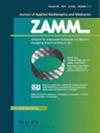恒定壁温线性拉伸薄板上的传热和流动分析:存在粘性加热的新颖局部非相似解
IF 3.2
4区 工程技术
Q1 MATHEMATICS, APPLIED
Zamm-zeitschrift Fur Angewandte Mathematik Und Mechanik
Pub Date : 2023-07-21
DOI:10.1002/zamm.202300003
引用次数: 1
摘要
本文章由计算机程序翻译,如有差异,请以英文原文为准。
Heat transfer and flow analysis over a linearly stretching sheet with constant wall temperature: Novel local non‐similar solutions in the presence of viscous heating
Flow over a linearly stretching sheet having constant temperature is examined in this article. The effects of frictional heating (viscous dissipation) and Ohmic heating (Joule dissipation) are also studied. As evidenced by the literature, energy equations are not always self‐similar when viscous dissipation is considered. It strongly depends on the form of stretching velocity and the surface temperature of the sheet. To facilitate the similarity transformations in these cases, one must find a constraint between the sheet velocity and the surface temperature. It is also observed that for the linearly stretching sheet with constant wall temperature, it is not possible to achieve self‐similar equations because in this case, a local variable appears in the viscous dissipation parameter. Hence, this problem corresponds to the non‐similar flow. In this analysis, pseudo‐similarity transformation is employed, and the viscous dissipation parameter is selected as a non‐similarity variable. Governing equations are transferred into non‐similar forms then a method known as Sparrow‐Quack‐Boerner (SQB) local non‐similarity (LNS) is used to derive the equations up to the second level of truncations which are then solved numerically. The slope linear regression (SLR) technique is used to compare the solutions obtained from the equations of the first and second levels of truncation.
求助全文
通过发布文献求助,成功后即可免费获取论文全文。
去求助
来源期刊
CiteScore
3.30
自引率
8.70%
发文量
199
审稿时长
3.0 months
期刊介绍:
ZAMM is one of the oldest journals in the field of applied mathematics and mechanics and is read by scientists all over the world. The aim and scope of ZAMM is the publication of new results and review articles and information on applied mathematics (mainly numerical mathematics and various applications of analysis, in particular numerical aspects of differential and integral equations), on the entire field of theoretical and applied mechanics (solid mechanics, fluid mechanics, thermodynamics). ZAMM is also open to essential contributions on mathematics in industrial applications.

 求助内容:
求助内容: 应助结果提醒方式:
应助结果提醒方式:


